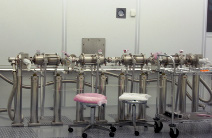 |
|
|
 |
Cautious optimism for US-university detector R&D funding
This month's Research Director's Report was written by Jim Brau, co-chair of the Worldwide Study and regional detector contact for the Americas.

Cornell/Purdue small time projection chamber (TPC) prototype (LEPP, Cornell) |
Several recent positive developments are moving us forward on the path towards realising the ILC. These include excellent detector R&D results and significant progress on the Letters of Intent (LOI) for the various detector concepts. These advances were reported at the recent Linear Collider Workshop at the University of Illinois in Chicago. While much of the R&D of the international ILC community has benefited from continuous support, in the US and in the UK we have struggled through a tough year. Now there is news that funding for university detector R&D in the US, which was cut severely last year, may be restored. This is good news because ILC detector R&D is far from finished, and continued and reliable support remains critical.
Read more...
-- Jim Brau
Research Director's Report Archive |
 |
|
|
 |
|
 |
From KEK: New beam line for R&D of nano-meter electron beam has been started at Accelerator Test Facility
A new beamline for R&D toward nano-meter electron beam has started operation at KEK's Accelerator Test Facility – ATF.
This new beamline, called ATF2, is an extension of ATF, and the focus of the research there will be on establishing the technologies for creation and control of a nano-meter-sized electron beam.
ATF is an accelerator complex at KEK for development of advanced technologies for future accelerators, including the International Linear Collider (ILC). ATF has been producing and using an electron beam with an extremely small vertical-emittance, as required by ILC. The new beamline, ATF2, was designed with a beam optics design scaled from the ILC's final focus system. Goals of R&D at ATF2 are to achieve a vertical beam size as small as 35 nm, and to establish the technologies for stabilizing this beam at the nano meter level.
Read more...
|
 |
|
|
 |
From New Scientist
20 January 2009
How do you weigh the Milky Way?
...the Milky Way's mass [ – saying it] is 50% heftier than thought and about as heavy as our nearest large neighbour, Andromeda.
Read more... |
|
From The Future of Things
19 January 2009
A Step Towards the Detection of WIMPs
A Canadian, American, and Czech team of astronomers has achieved a higher separation of WIMP interactions from other interactions in a dark matter detector that previously achieved.
Read more... |
|
From CERN Bulletin
16 January 2009
The latest from the LHC
As of last week all magnets in the damaged area of sector 3-4 have been removed and raised to the surface...
Read more... |
|
From Nature
(subscription required)
16 January 2009
Science wins big in US economic plan
Congressional stimulus package includes billions in extra research funding.
Read more... |
|
From Neteo
15 January 2009
Aceleradores de partículas de bolsillo
Algún día, los físicos de partículas querrán actualizar el LHC a un modelo mayor, mejor y más caro. De hecho, ya están trabajando en su sucesor conocido como el Colisionador Lineal Internacional.
(in Spanish)
Read more... |
|
|
 |
Training the next generation of accelerator scientists
The Third International Accelerator School for Linear Colliders

Linear Collider School poster |
took place from 19 to 20 October 2008 at the Oakbrook Hills Marriott Hotel near Chicago, Illinois, U.S.A. and was a continuation of the previous two international LC accelerator schools held in 2006 in Japan and 2007 in Italy.
This year’s school was jointly organised by the ILC Global Design Effort, the International Linear Collider Steering Committee (ILCSC) and the ICFA Beam Dynamics Panel. Fermilab hosted the school. Training the next generation of accelerator scientists is crucial for the future of the field and the role and success of our series of schools is now well established.
Read more...
-- Barry Barish
Director's Corner Archive |
 |
|
|
 |
A string attached

The 3.9-GHz cryomodule string you read
about two weeks ago
is now complete: the fourth cavity was successfully tested and installed into the string of cavities pictured
above in the MP-9 clean room. The cavity string was moved for module assembly this week.
Read more here
|
 |
|
|
 |
Correction
Last week's Image of the Week ran with an incomplete caption. It should have read:
Two units of high-power couplers to use with L-band superconducting cavities, sent from LAL, France to KEK, Japan.
These couplers, with "TTF5 design", have been delivered to KEK as part of the France-Japan Particle Physics Laboratory
(FJPPL) programme
and will be high-power tested at
STF at KEK in early 2009. The design of these couplers have been developed by DESY with some modification applied by LAL.
Its R&D was done as part of the CARE programme and the couplers were fabricated by ACCEL company.
We apologise for the error.
arXiv preprints
0901.2821
Angular distributions as a probe of anomalous ZZH and gammaZH interactions at a linear collider with polarized beams
0901.2397
ILC Instrumentation R&D at SCIPP
0901.2257
Higgs boson pair production through gauge boson fusion at linear colliders within the general 2HDM
0901.2228
Test Beam Requirements for the ILC Tracking and Vertex Detectors
0901.2099
Unparticle physics and neutrino phenomenology
0901.1759
Study of Solid State Photon Detectors Read Out of Scintillator Tiles
|
|

